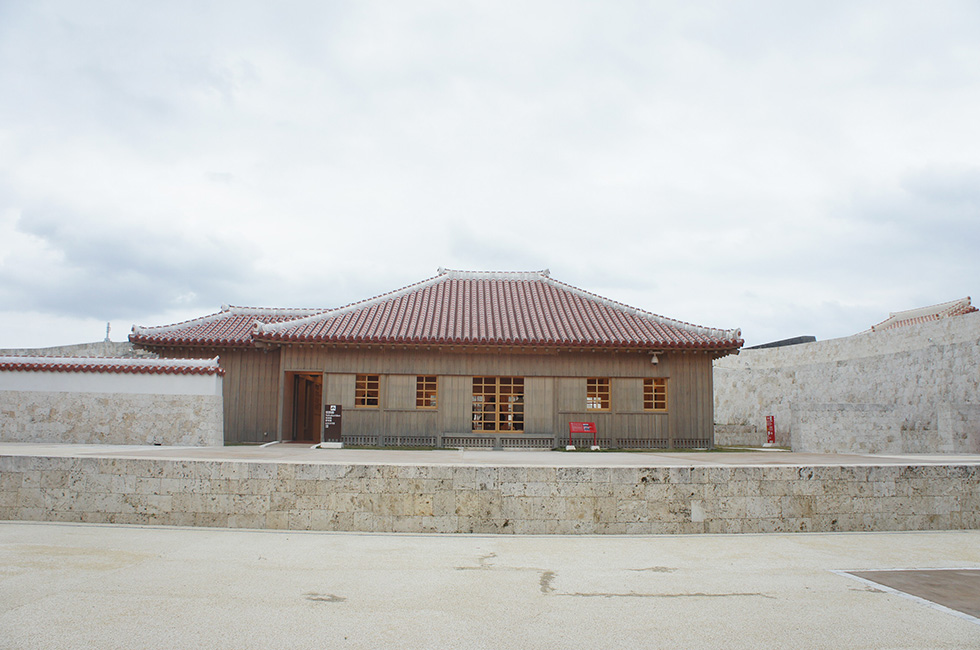Ouchibara
Home > Visitor’s Guide > Ryukyu Kingdom exploration ~American writer's gaze~ > Ouchibara
Ouchibara

The Ouchibara (inner field) was largely designed as residential space to support the daily lives of the royal family, including eating, sleeping, education, cultural training, and leisure. Female court attendants resided here, though access was forbidden to males outside the royal family. The Ouchibara also accommodated ceremonies connected with the royal family, such as funerals for kings and rites of succession for their offspring. Important sanctuaries called utaki were located on the site and have been restored. Two major buildings that were recently reconstructed fortunately escaped damage from the fire in 2019.
Women’s Realm
The Ouchibara was intended to be private, domestic, and female in character. This was in contrast to the formal Una courtyard, which was bounded by the Seiden and other administrative and ceremonial buildings and could be characterized as public, political, and male. The queen and royal princesses lived in the Ouchibara, as did princes who had not yet come of age. The royal family was attended here by ladies of the court who had studied traditional culture and etiquette. As a general rule, the king and princes were the only males allowed to enter, but their living areas were set apart, and the Ouchibara was reserved as a realm of women. Although much of the activity in the Ouchibara was centered on daily needs, including weaving royal garments, a large part was devoted to cultural training, such as mastering court protocol, and studying ceremonial roles.
Layout with Terraces and Courtyards
The Ouchibara extended over several terraces that ascended eastward from the Seiden. The main living spaces surrounded a large courtyard called the Kushi no Una. To one side of the courtyard was the Yosoeden, a large building that housed the queen’s personal living quarters and was the center of administration for the Ouchibara under her oversight. This structure has not yet been restored. Next to it was the Yohokoriden, a residential structure the size of a large house, which usually served as the sleeping chambers for unmarried princesses and was partly surrounded by Ryukyuan-style stone walls enclosing small gardens. Upon the death of a king, however, this was where the accession ceremonies for the crown prince were held. A storehouse for jewels, called a kanegura, was located directly behind the building. The Yohokoriden was reconstructed in 2019.
The Kushi no Una courtyard was bounded on the other side by the Nyokan Kyoshitsu. Strongly residential in character, this was the living quarters for female court attendants, known as nyokan. Approximately 100 nyokan served at the castle, including those who lived there and others who lived nearby. The latter were chosen from prominent families who had residences in Shuri, allowing them to travel to the castle daily to perform their duties. It is believed that the women who lived at the Nyokan Kyoshitsu came from rural areas far from Shuri. A large bath, or yuya, was located behind the Nyokan Kyoshitsu, and a reservoir provided fresh water. The main residential area of Ouchibara also contained religious sanctuaries called utaki.
Shinbyoden
The area behind the Yohokoriden is narrower, more steeply terraced, and more ceremonial in character than the Kushi no Una courtyard. The innermost and highest enclosed terrace immediately beneath the Agari no Azana lookout tower is known as the Shinbyoden, and can be considered the inner sanctum of Shuri Castle. It is surrounded by tall, massive castle walls on all sides, and like the Tamaudun Royal Mausoleum a few hundred meters away, it is paved with white coral gravel as a sign of purity and mark of respect. Kings were temporarily laid to rest here upon their deaths, and ceremonies were performed here as part of funerary and succession rites. The main gate to the Shinbyoden is called the Hakuginmon (Silver Gate), and is an arched opening in the high stone wall surmounted by a roof of carved stone. Only the king’s successor was allowed to pass through this gate.
© Shurijo Castle Park All Rights Reserved.


